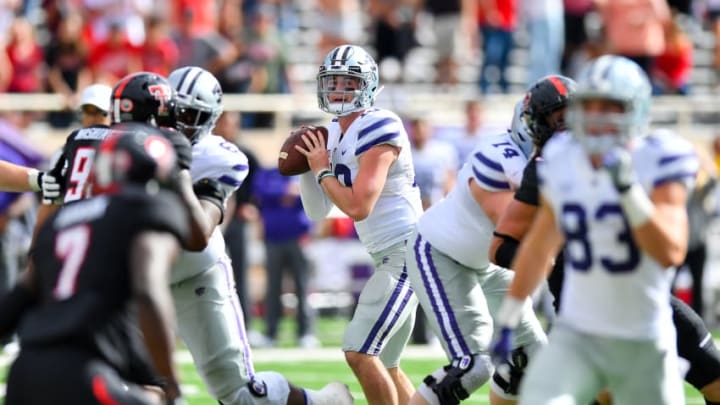Cactus Bowl 2017: UCLA Football defense vs. Kansas State offense

Kansas State Run Game
Let’s get the bad news out of the way first. Kansas State wants to run the ball and they’re going to be able to. Their offensive line is powerful but not overly athletic. What they are is sound in their assignments and technique. Often disciplined technique from lesser quality athletes can beat more athletic players who freelance and rely on talent.
The Wildcats run a heft of their plays out of 11-personnel or one tight end and one running back although they will bring in a second TE to lineup in line when they want an extra blocker in the run game.
Skylar Thompson may have been third on the depth chart to start the season but when he was handed the keys the offense the young freshman displayed not only the ability to be a dangerous runner but also the strong arm to make defenses pay when they try to crowd the box. What he lacks in experience he makes up for in moxie and is prone to tucking the ball whether it’s a designed QB run or not.
Just as many other spread teams do, the Wildcats love to spread the field on designed QB runs with four wideouts and offset running back as a lead blocker. They of course also implement plenty of read-option concepts as well and between starting RB Alex Barnes and Thompson, defenses are forced to pick their poison.
The aforementioned Barnes is going to give the UCLA Football defense fits. He’s not a burner and isn’t the most dynamic player out of the backfield. Instead he’s a blue collar, hard-nosed, contact seeking ball carrier. He’s a bit of a long strider but once he gets going he’s difficult to bring down. Dalvin Warmack will spell Barnes and is more of a jitterbug player but with his compact frame he’s surprisingly strong and isn’t just a scatback.
One player to keep your eye on is fullback Winston Dimel. Not the biggest or most athletic back on the roster, Dimel epitomizes Kansas State football with his tough style. He will occasionally receive a carry or catch a pass but where he excels and is most valued is as a lead blocker.
Like I said before, this offensive line isn’t the most athletic and in fact they’re strong but not overwhelmingly so. If you stack the box and can actually slow the run then you should be in good position to hold the point of attack. However, the UCLA Football defense has struggled with not only putting enough bodies in the box but even when they do they’re constantly out of position to make the tackle or don’t attack the play.
The strength of this offensive line is on the edges behind RT Dalton Risner and LT Scott Frantz. Frantz is actually a devastating puller and when he’s out in front on off-tackle runs look for big yards to be gained. Both are very solid run blockers but leave something to be desired in the pass protection market. More on that later.
The longer developing off-tackle run with a pulling guard or tackle are a favorite for Kansas State because it doesn’t ask a player like Barnes to try and out run anyone to the edge. Instead it allows the OL to keep everything in front of them and the RB to follow his blockers. This is a well coached group but clearly limited. For the Bruins to stop this group they need to have their DL hold their blocks and not allow the Wildcat offensive line to disengage and move up to the linebackers. This UCLA defense is going to need to be aggressive but has struggled mightily to defend the read-option in 2017.
The UCLA Football team had some of their most consistent success when they deployed a 3-4 look against the Memphis Tigers with Keisean Lucier-South and Jaelan Phillips operating as the stand up LBs. That athleticism on the edge gave the Bruins a better ability to hold the edge and defend the QB runs instead of asking one of their DL to give chase. I wouldn’t be surprised to see this look deployed again from the Bruins.